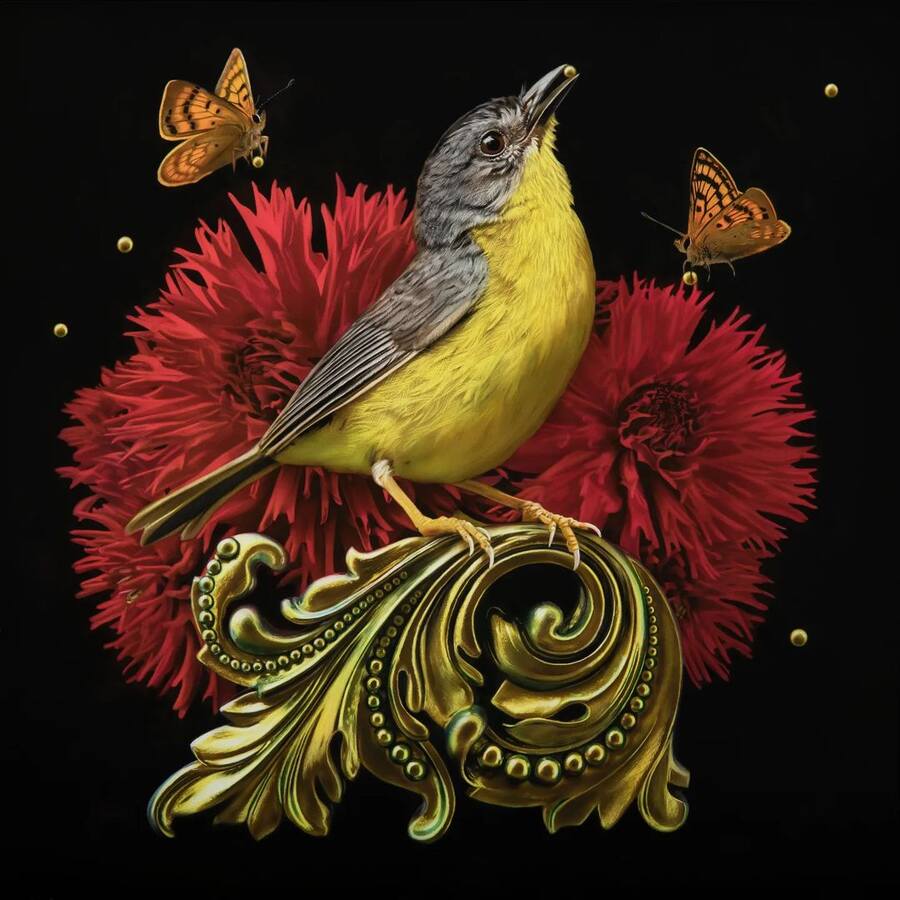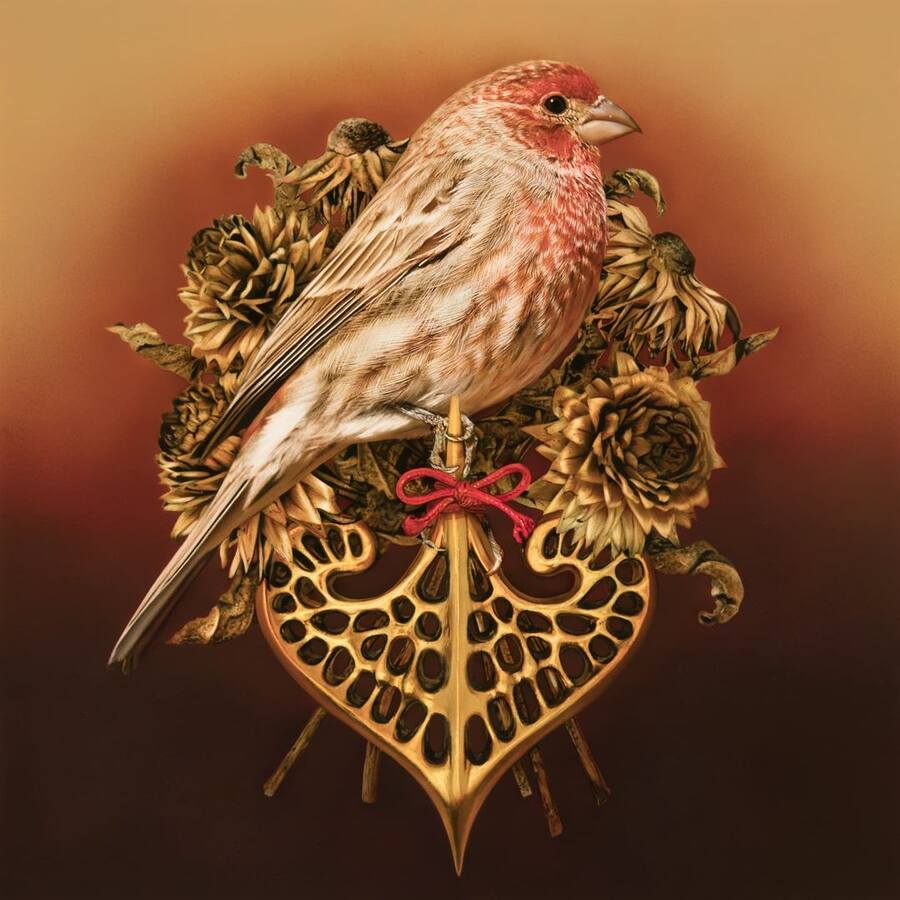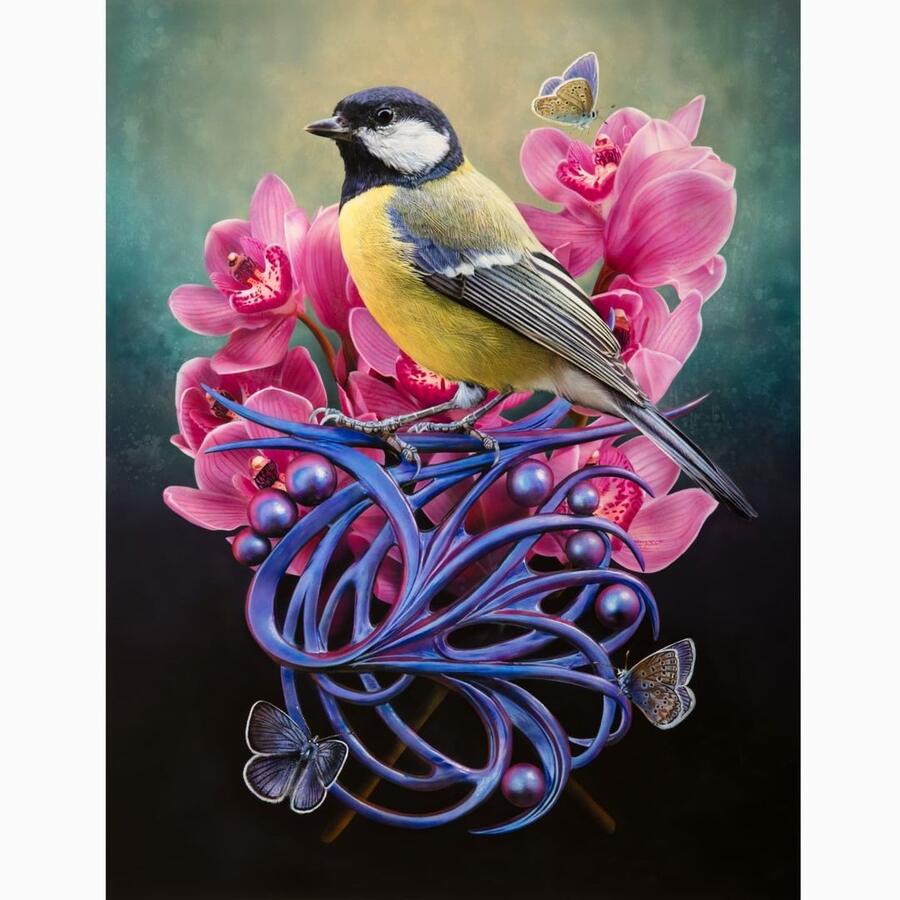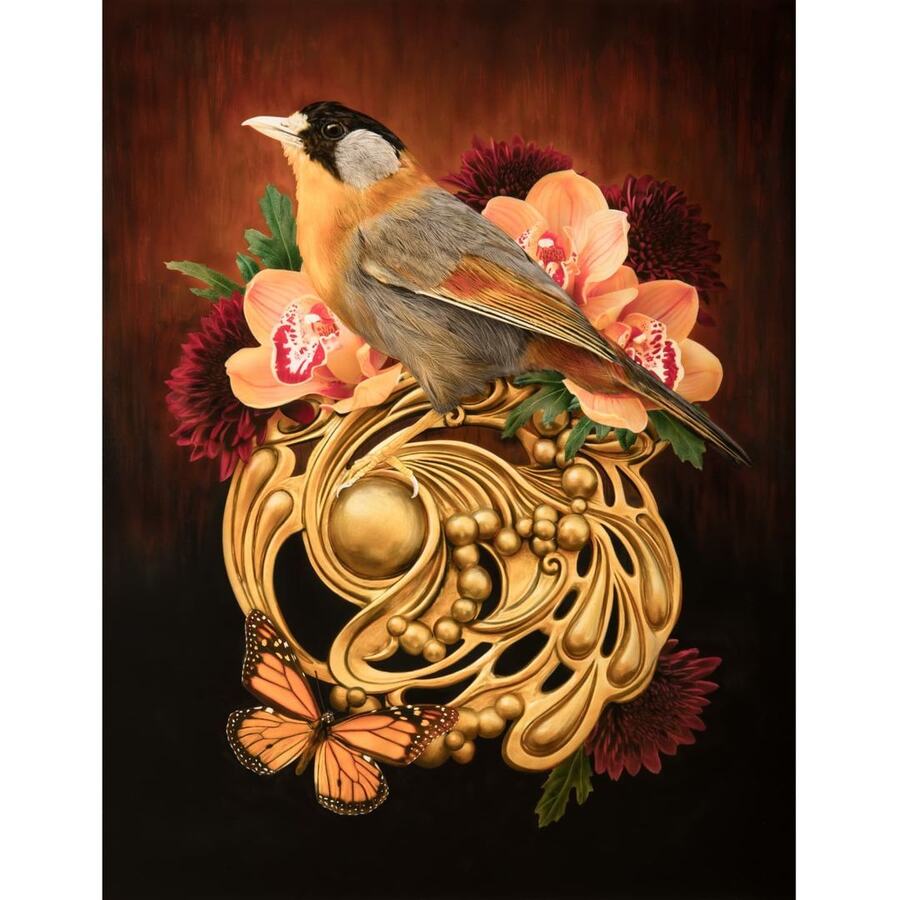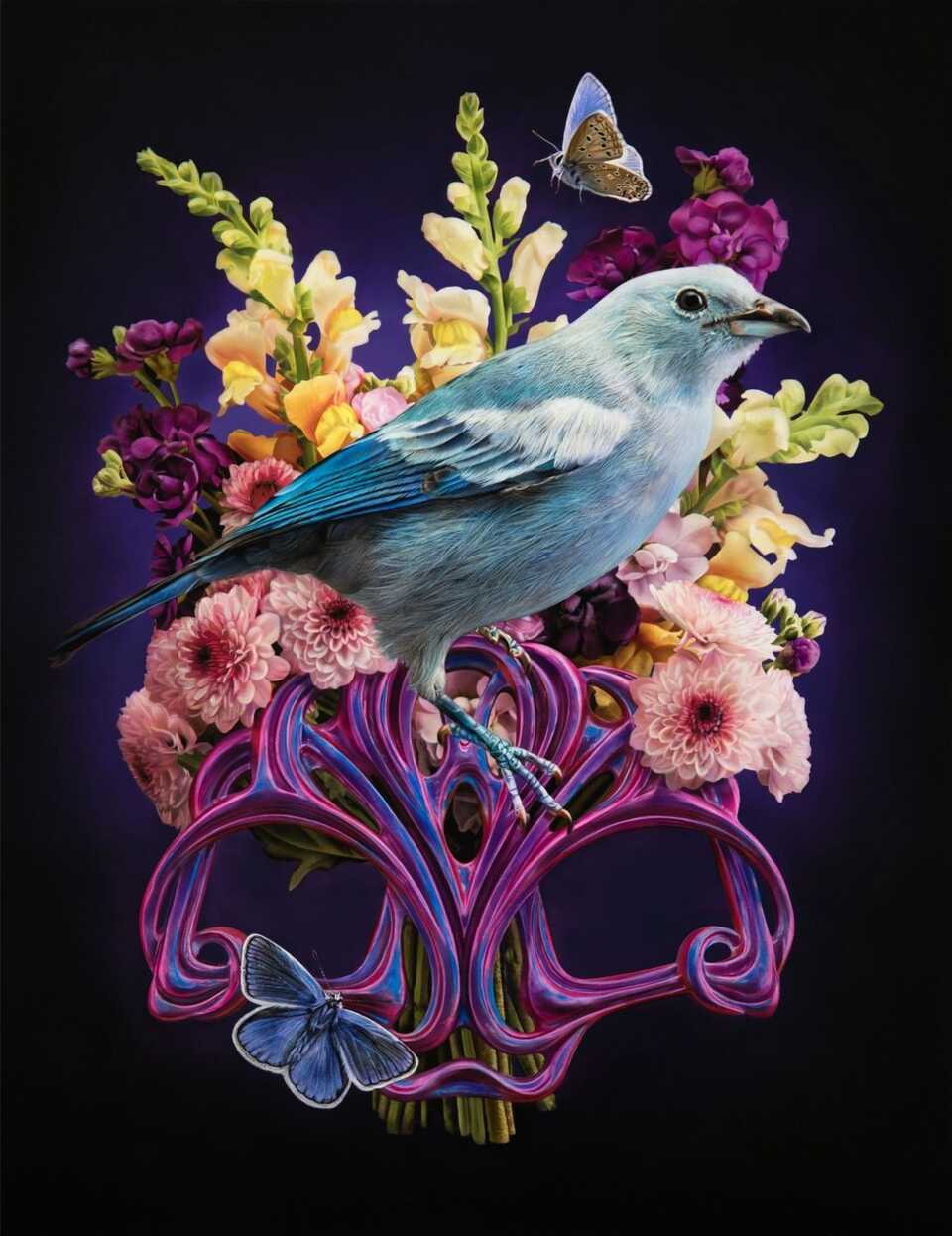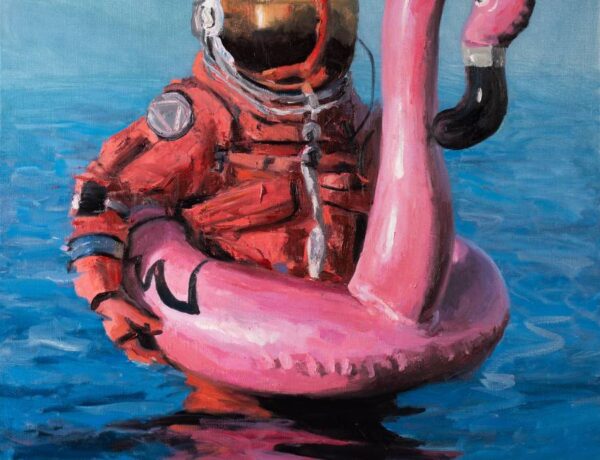Traditional wildlife studies from the early 20th century and prior, whether through age or technique, often appear drab: dull earthy tones are broken by the occasional muddy blue or green. Exotic birds may appear occasionally bring reds or oranges to the mix but still the overall look is desaturated.
In contrast to those early studies, the work of Melinda Jane leaps of the page. Abstract, colour saturated shapes replace dull leaves and branches while almost perfectly realistic birds practically leap out of the canvas giving the illusion, just for a moment, one could reach out and encourage the avian specimen to perch on their finger.
I think of it like a jigsaw puzzle, as each piece slots into place I begin to see the overall picture emerge. The satisfaction for me comes at the end seeing a piece completed.
Exclusive Interview with Melinda Jane
Talking to different artists, many were encouraged as children to be creative and grew up in a creative household. Is this true of your childhood and is there a significant moment in your youth that encouraged you to become an artist?
Yes, both my parents have always been supportive and have encouraged me to follow my creative interests. Creativity has always been a part of who I am and is something I have just done; I don’t remember a time in my childhood or life where it wasn’t.
There was one significant moment I remember that encouraged me on my path as an artist. My Mum had enrolled me in an after-school program at the local arts centre when I was around 7 years old. At one of the classes, they had us each create a painting based on the theme “The City” that was going to be entered into an international art competition being held in China. I created a painting of an evening city scape right at sunset which they entered into the youth section of the competition.
After completing the painting, I didn’t think of it again, until months later when an envelope arrived in the mail addressed to me. My Mum, being concerned that her child was receiving random mail from China, wouldn’t let me open the letter, but she did open it while I was with her. It turned out I had come in second place and there was a letter of congratulations as well as cheque for a couple of hundred dollars prize money. I remember clearly my Mums confusion as I explained about the competition, then the look of shocked elation on her face as she looked between me and the cheque. She was completely blown away and her reaction is the part that I remember the most. It made me realise that maybe art could be something more in my future than just a hobby.
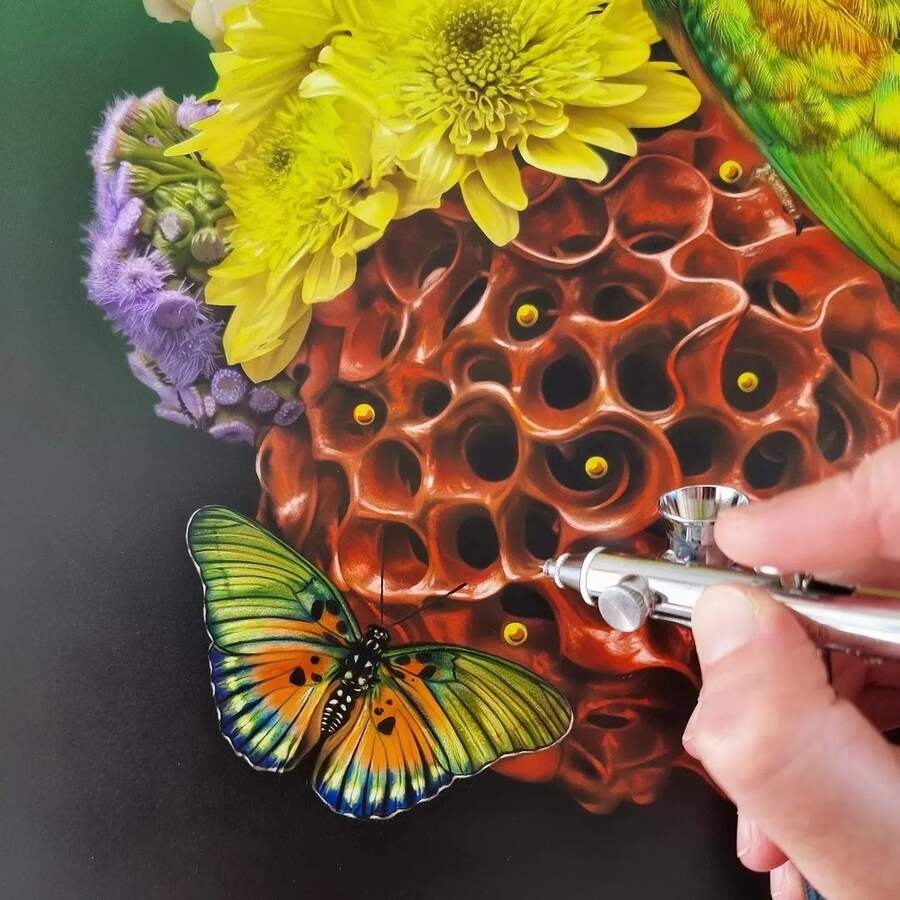
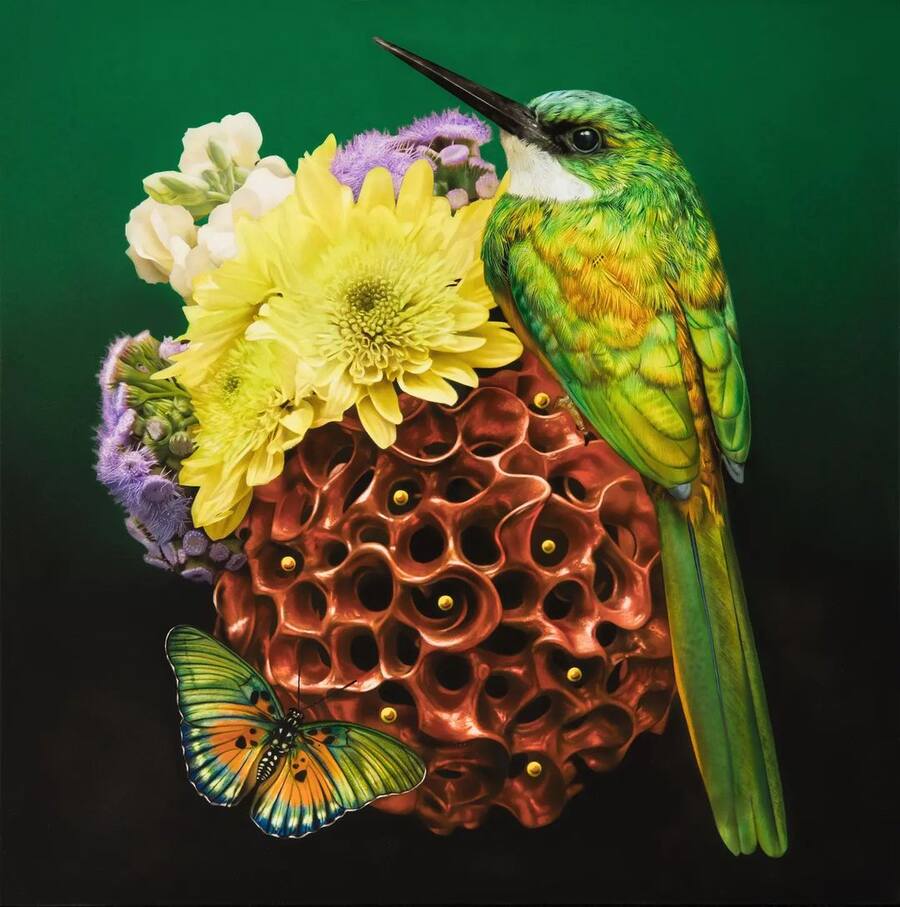

Do you find yourself constantly chasing the high you received as a child or are there other challenges you set yourself?
No, I try not to chase the high of external validation. I don’t think it’s healthy for any artist’s self-esteem to focus too much on what others think. There are always going to be people who appreciate your work and there is a definite thrill – for example, when an artist you personally admire likes one of your paintings on social media. But there will always be people who don’t like what you do and if you’re focused on external validation the weight of one negative comment can suddenly feel like it outweighs all the positive.
I stay focused on my personal goals.
I plan my work out well in advance and break down every single step of a painting into bite sized chunks that need to be achieved so that the daily work/process becomes a challenge to be accomplished.
I think of it like a jigsaw puzzle, as each piece slots into place I begin to see the overall picture emerge. The satisfaction for me comes at the end seeing a piece completed.
Even before you begin to paint your process is quite intense. Can you please explain the different skills and steps you take before you even lay paint on panel?
Ideas come to me as fully completed images in my head. I normally do a sketch of the idea while it is clear in my mind so it’s easier to recall the details later on. I have a lot more ideas than I do time, so generally I sketch them out then let them sit. I find the stronger ideas are the ones that won’t leave, and keep popping back into my head.
Once I decide to start on a painting, I begin by focusing on the parts of the final image that will need to be created in a physical sense for my reference as it doesn’t actually exist in reality. Because my goal is to push my final work as close to photo realism as possible, I actually make/construct the imagined parts of the painting.
I do a detailed drawing of the organic shape or design element to use as a sculpting reference before I begin making a maquette of it in clay. I generally have an idea the size the painting will be once complete so I make the maquette to the same scale that it will appear in the final image.
Once the sculpt is complete, I mold it and then cast it in resin. Some sculpted pieces are complete at that stage, others may require priming, painting or gilding in gold leaf.
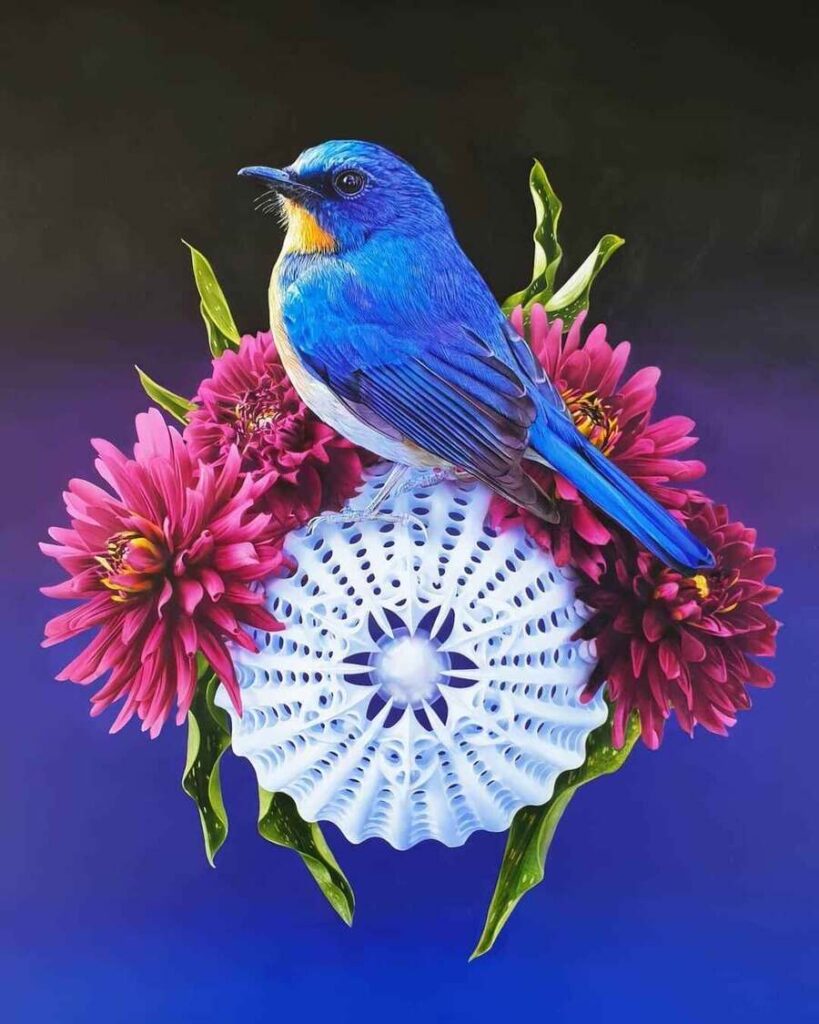

I pull together as many of the elements that I plan to use for my reference as possible, like flora, fauna, sculpture etc. and set them up for a photo shoot. As a large number of the bird/insect components have previously been photographed in the field, I take the time to correctly match the lighting conditions in my studio photography to enhance the realism.
I then pull all the photos together in Photoshop and create a full and final digital composite that will be the reference I work from for my painting. Then, after sanding, priming, and a little more sanding of an aluminum composite panel I am ready to actually begin airbrushing the painting.
I don’t know about others but I tend to think of airbrush as one of the rarer tools used in fine arts or of its use in the automotive industry. What drew you to using one?
Probably the biggest draw was during high school when I discovered the work of H.R Giger. A local comic store had one of his books for sale which I purchased and then poured over, reading it cover to cover. I was so fascinated by his work that I ended up getting the store to special order in as many of his books as they could find (this was pre internet/Amazon days). Learning about his technique using an airbrush and the results he got just blew my mind.
Around the same time one of the art teachers at school set up an airbrush he had used for illustration work and we all had the opportunity to try it out. I was instantly hooked!
I also think growing up in and around the Automotive Industry with my parents owning and running a repair/refinishing shop helped demystify the process and made airbrushing feel accessible to me.
It wasn’t all smooth sailing though.
I played around with it for a long time but just couldn’t seem to get the results I wanted. I would put it away out of frustration and then come back to it again and again. The biggest turning point was in 2014 when I jumped on a plane to America and took a number of classes at Dru Blair’s airbrushing school in South Carolina. The knowledge & techniques I learnt there gave me the skill set to be able to bring my work to life in the way I wanted.
There are a lot of pros to using an airbrush like the effortless smooth transitions which make blending easy, the fast-drying times and the flawless finish. For me it is the level of detail you can achieve. With the right air pressure and paint reduction you can paint fine lines which are as thin as a human hair.
The possibilities with an airbrush are endless.
I would say as far as negatives go, it’s the initial set up costs can be the biggest deterrent as well as knowing where to start and what to buy. Especially if you haven’t had the chance to try airbrushing before investing your money in a compressor, airbrush, airline hose, parts as well as paint and substrate. There is a lot of information online, you just have to sift through it and consider what you’re wanting to achieve so you can find what will work best for you and your budget.
My goal is to create a beautiful, highly rendered piece that captures a moment; blurring the line between reality and fantasy, while quietly whispering meaning to the viewer.
Your work is characterised by photorealistic details from nature juxtaposed with colourful abstracted shapes. Were these elements always present in your work or a result of evolving your style?
I think it has been a natural evolution in the style of my work which began with an interest in photo realism and has slowly developed into creating work that spills over into the surreal.
I have a dual fascination with organic shapes inspired by the strange and unusual things that occur in nature and also with historical design. I draw so much inspiration from the highly skilled artisans of the past who created interiors, furniture, porcelain & jewelry during periods such as the Rococo, Baroque & Art Nouveau.
In my own work I am always looking for ways to fuse these elements with the natural world in a contemporary way. My goal is to create a beautiful, highly rendered piece that captures a moment; blurring the line between reality and fantasy, while quietly whispering meaning to the viewer.
What is a typical day in your studio like? Is there a playlist you return to? A podcast you tune into or is silence the key to your productivity?
No matter what I have planned in the studio for the day, it always starts with coffee…and then more coffee. I try to be in the studio ready to start work by 9am and jump straight in to airbrushing. I normally stop around 2:30-3pm when my son comes home from school, and take a longer break.
Then, all going well, I get another couple of hours in before finishing for the day. I prefer to work during the daylight hours to maximize the quality of light in my studio. I do have a great lighting set up, but find it easier to work in natural light. I also find that the intense level of concentration I use while painting leaves me feeling drained after a while, so I generally manage 5-6 hours of painting time per day.
I always listen to music while working, I find it helps me focus and helps quiet my mind. I have a hefty 15-hour playlist of music on Spotify, which I put on shuffle or I listen to Art related podcasts like ‘The Dark Art Society‘, ‘Drawing from Experience‘ and ‘Art Affairs‘.
What are some of the challenges you face as an artist and how do you overcome them?
I think like any creative person it can be a challenge to stay focused on your own work and not be distracted by the amazing things so many other artists are doing. Looking online and seeing the incredible things they are creating in so many different mediums and styles always leaves me feeling so inspired. It fills my mind with new ideas and makes me want to branch out and try new things.
I find I have to rein myself in and remember I can only walk one path at time.
I try to distil down to what it is exactly about another artist’s work that has me feeling so inspired to see if there is anything that I can learn or carry over and apply to my own work in an original way. Sometimes I’m successful in avoiding falling down a rabbit hole of distraction and then other times I end up with a lot of random art materials sitting in my cupboards for projects I never get around to starting
To me inspiration feels effervescent, like endless creative possibility.
So, when I see art that conjures that emotion, I try to work out what it is about that specific piece that makes me feel that way. It’s like trying to decode the ingredients of a secret recipe so you can add a pinch of it to your own work.
It makes me want to paint and to create.
On the flip side, I think everyone wishes at some point that they could be more like someone else. But, by focusing on what you feel you lack in a non-constructive manner, it can quickly spiral you into an array of negative emotions that can be paralysing to both your work and creativity. I honestly don’t think self-doubt ever gets silenced, it’s more about how much credence you choose to give it.
What response would you like to elicit from the viewers of your painting – both their immediate reaction and on reflection?
I like to think that viewers are drawn to the bright, colour drenched beauty of a curious moment frozen in time. Then, upon reflection, they consider the vast, beautiful world of nature that exists outside the walls we live in. I hope it resonates just how fascinating, precious and fragile our natural world can be and how important it is for us to cherish and care for it.
How do you see both your own art and the role of art galleries evolving in the future?
For the evolution of my personal work, I am focusing on going bigger, not just in the physical size of the pieces, but also in stuffing my compositions to the brim with the beauty of various forms of flora and fauna.
I want to begin introducing multiple characters to my paintings so that I can play with the interactions between them to create an interesting narrative.
The question I am asking for my future work is how much becomes too much and how far I can push myself?
Galleries in my opinion, are the contemporary version of a museum but with added bonus of art that is available for sale. I think they are an important destination where people can go to experience work in person and I hope that despite the rise of the online world, they don’t evolve past having a physical space where art can be shared and celebrated in a social setting. Having a gallery that champions your work and that helps alleviate some of the marketing/sales/shipping/business aspects of art allows artists to focus on their craft and producing new pieces. It can be the perfect symbiotic relationship and I hope that galleries and artists will continue to evolve together.


